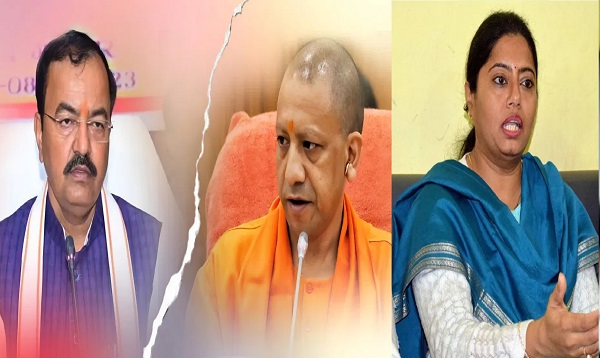Paromita Das
GG News Bureau
New Delhi, 30th July. In the dynamic landscape of Uttar Pradesh (UP) politics, Chief Minister Yogi Adityanath has once again demonstrated his strategic acumen by meeting with Pallavi Patel, a move that sends a clear message to his political rivals. This meeting is significant not only for its timing but also for the underlying rifts it highlights within the ruling coalition and the opposition. Two major political rifts have come to the forefront: one between Yogi Adityanath and his Deputy, Keshav Prasad Maurya, and the other between Yogi and Apna Dal (Soneylal) [AD(S)] leader Anupriya Patel.
Background of the Rifts
- The Yogi-Maurya Rift:Keshav Prasad Maurya, a prominent leader from the Other Backward Classes (OBC) community, has been a key figure in the Bharatiya Janata Party’s (BJP) UP unit. Despite being Yogi’s deputy, Maurya’s relationship with the Chief Minister has been strained. The roots of this tension lie in the complex dynamics of UP’s caste-based politics and the BJP’s internal power struggles. Maurya’s substantial support base and his aspirations for a greater role have often clashed with Yogi’s authoritative style and his positioning as the face of Hindutva in the state. This friction has led to a cautious but visible distance between the two leaders, with Maurya sometimes publicly contradicting Yogi’s statements or policies.
- The Yogi-Anupriya Patel Rift:Anupriya Patel, the leader of the Apna Dal (Soneylal) [AD(S)], has been an ally of the BJP, providing crucial support in the state’s coalition politics. However, the alliance has not been without its challenges. Anupriya, a key leader among the Kurmi community, has expressed dissatisfaction with the BJP’s handling of coalition partners, particularly regarding the allocation of seats and representation in the government. The tension between Yogi and Anupriya has been palpable, with her occasionally criticizing the state government’s policies and decisions, indicating a simmering discontent.
The Pallavi Patel Meeting: A Strategic Move
The recent meeting between Yogi Adityanath and Pallavi Patel, a political figure associated with the opposition Samajwadi Party (SP) and sister of Anupriya Patel, is loaded with political symbolism. Pallavi, who has often taken divergent stances from her sister, represents a different faction within the Patel family and the broader Kurmi community. This meeting can be interpreted as Yogi’s attempt to create fissures within the opposition ranks and, simultaneously, within the Apna Dal itself.
By engaging with Pallavi, Yogi Adityanath appears to be sending a signal to both his allies and adversaries. To his allies, it serves as a reminder of the BJP’s dominance and the party’s ability to navigate coalition politics deftly. To his adversaries, especially the Samajwadi Party and the Apna Dal, it underscores his readiness to exploit internal divisions for political gain. The meeting also highlights Yogi’s broader strategy of consolidating support among various caste groups, a crucial factor in UP’s electoral politics.
Yogi’s Whole Gimmick
Yogi’s meeting with Pallavi could potentially have an impact on Anupriya Patel. AD(K) has been competing for the political space previously held by Anupriya’s AD(S). With the AD(S) struggling in previous elections, the BJP may look for new allies to capture Kurmi support.
Apna Dal(S) won only one of the two seats it ran for in Uttar Pradesh. Anupriya’s victory margin shrank dramatically, and her party failed to help the BJP win other Kurmi-influenced seats. In contrast, the SP-Congress combination won many Kurmi-dominated seats.
Despite her bleak performance, Anupriya confronted Yogi, alleging unfairness against OBC and Scheduled Caste and Tribe candidates in state government employment recruitment. This move may have pushed Yogi to examine other allies.
Pallavi’s meeting with Yogi could be an attempt to keep AD(K) relevant in UP politics. Yogi, on the other hand, may be hesitant to join up with a party that has yet to win an election. Instead, he might utilize this conversation to inform Anupriya that he has other options, discouraging any revolt.
Conclusion
As UP gears up for upcoming elections, these internal rifts and political maneuvers will play a significant role in shaping the state’s political landscape. Yogi Adityanath’s calculated outreach to Pallavi Patel is a testament to his political savvy and his determination to maintain a strong grip on power, despite the underlying tensions within his own party and among coalition partners. This move sets the stage for a potentially volatile political season, with alliances and rivalries likely to shift as the state’s major players jockey for position.


Comments are closed.